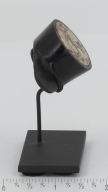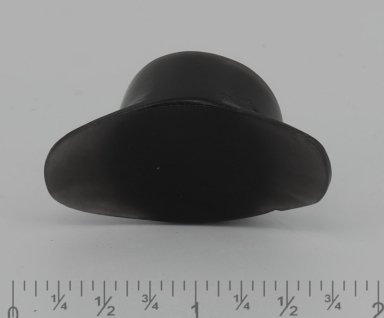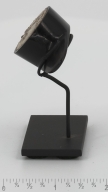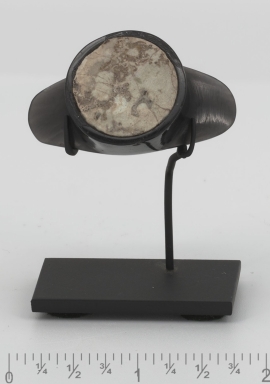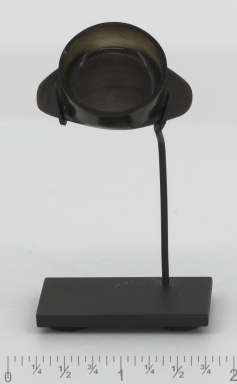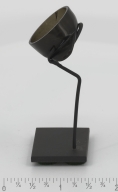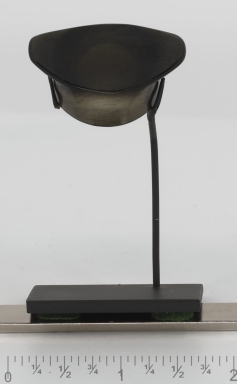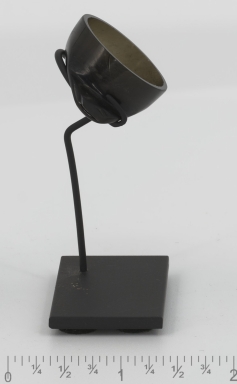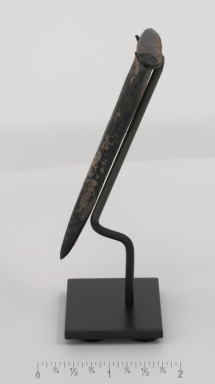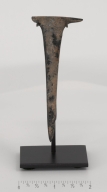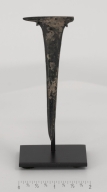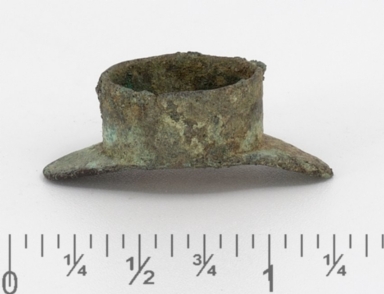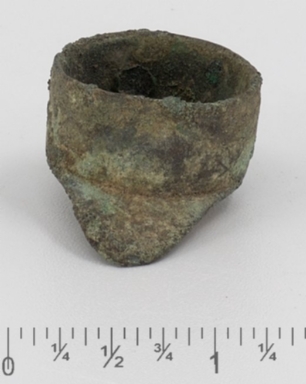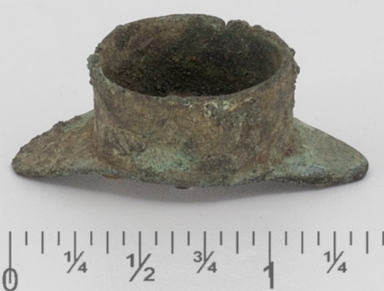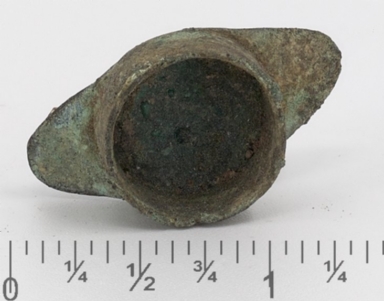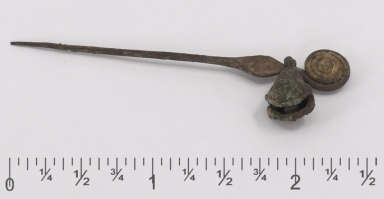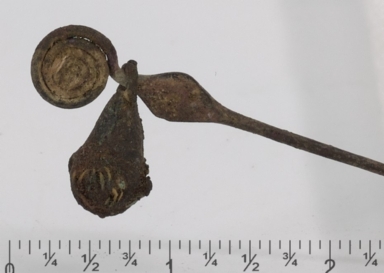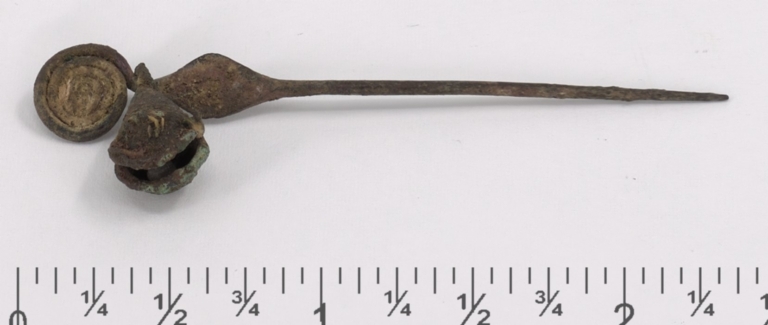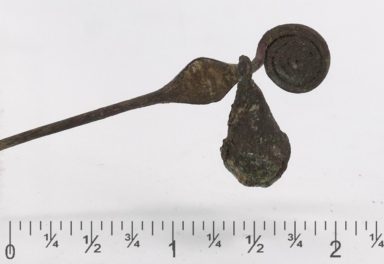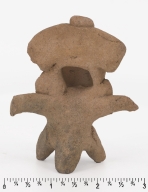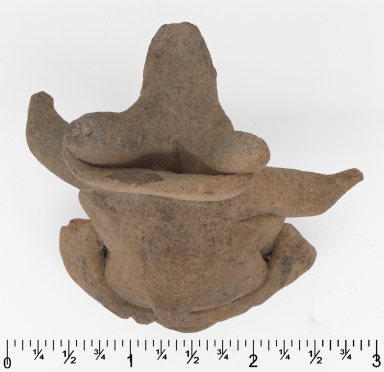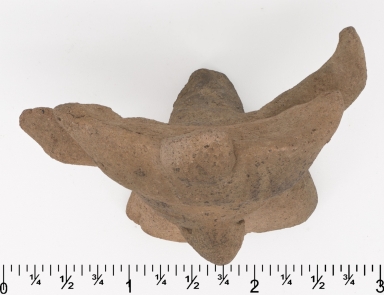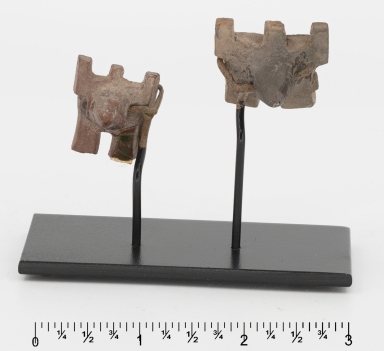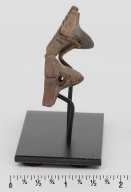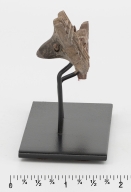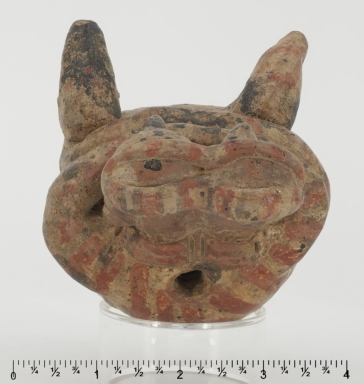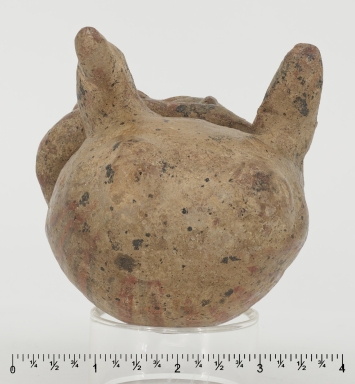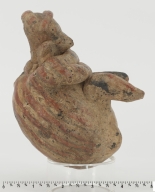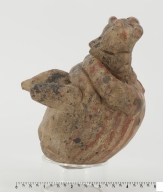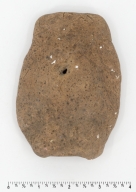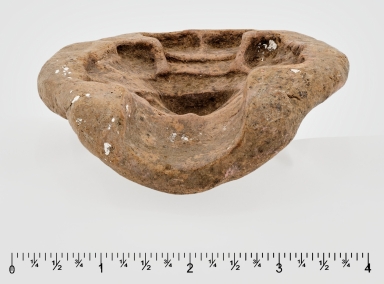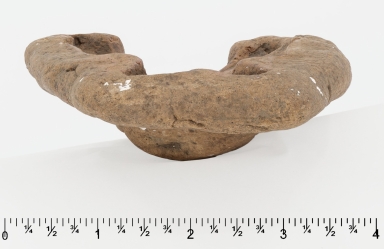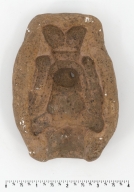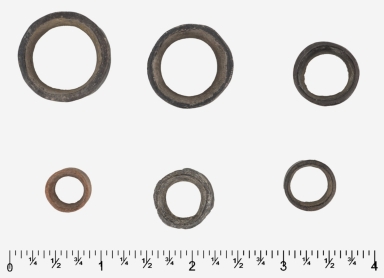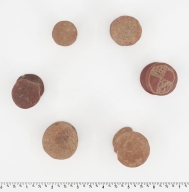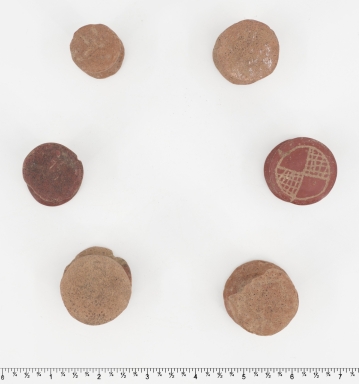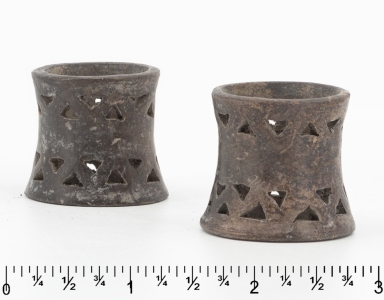Who What Where WhenREMOVEWHATShow More |
Title
Three obsidian winged labrets : B.
Description
Obsidian is a volcanic glass-like stone cleaves concavely. Working with obsidian requires great skill. The process involves core flaking, pressure flaking, drilling, abrading as well as polishing. It is very labor intesive. Two of the labrets have been inlaid with a white material.
Subject
[Labrets, Jewelry--Mexico, Stone carving--Mexico, Obsidian--Mexico, Art--Mexico, Indigenous Peoples--Antiquities]
Date
between 900 and 1523
Title
Three obsidian winged labrets : B.
Description
Obsidian is a volcanic glass-like stone cleaves concavely. Working with obsidian requires great skill. The process involves core flaking, pressure flaking, drilling, abrading as well as polishing. It is very labor intesive. Two of the labrets have been inlaid with a white material.
Subject
[Labrets, Jewelry--Mexico, Stone carving--Mexico, Obsidian--Mexico, Art--Mexico, Indigenous Peoples--Antiquities]
Date
between 900 and 1523
Title
Three obsidian winged labrets : B.
Description
Obsidian is a volcanic glass-like stone cleaves concavely. Working with obsidian requires great skill. The process involves core flaking, pressure flaking, drilling, abrading as well as polishing. It is very labor intesive. Two of the labrets have been inlaid with a white material.
Subject
[Labrets, Jewelry--Mexico, Stone carving--Mexico, Obsidian--Mexico, Art--Mexico, Indigenous Peoples--Antiquities]
Date
between 900 and 1523
Title
Three obsidian winged labrets : B.
Description
Obsidian is a volcanic glass-like stone cleaves concavely. Working with obsidian requires great skill. The process involves core flaking, pressure flaking, drilling, abrading as well as polishing. It is very labor intesive. Two of the labrets have been inlaid with a white material.
Subject
[Labrets, Jewelry--Mexico, Stone carving--Mexico, Obsidian--Mexico, Art--Mexico, Indigenous Peoples--Antiquities]
Date
between 900 and 1523
Title
Three Obsidian Winged Labrets, a
Description
Obsidian is a volcanic glass-like stone cleaves concavely. Working with obsidian requires great skill. The process involves core flaking, pressure flaking, drilling, abrading as well as polishing. It is very labor intesive. Two of the labrets have been inlaid with a white material.
Subject
[Labrets, Jewelry--Mexico, Decoration and ornament--Mexico, Stone carving--Mexico, Art--Mexico, Indigenous peoples--Antiquities]
Date
between 900 and 1522
Title
Three Obsidian Winged Labrets, a
Description
Obsidian is a volcanic glass-like stone cleaves concavely. Working with obsidian requires great skill. The process involves core flaking, pressure flaking, drilling, abrading as well as polishing. It is very labor intesive. Two of the labrets have been inlaid with a white material.
Subject
[Labrets, Jewelry--Mexico, Decoration and ornament--Mexico, Stone carving--Mexico, Art--Mexico, Indigenous peoples--Antiquities]
Date
between 900 and 1522
Title
Three Obsidian Winged Labrets, a
Description
Obsidian is a volcanic glass-like stone cleaves concavely. Working with obsidian requires great skill. The process involves core flaking, pressure flaking, drilling, abrading as well as polishing. It is very labor intesive. Two of the labrets have been inlaid with a white material.
Subject
[Labrets, Jewelry--Mexico, Decoration and ornament--Mexico, Stone carving--Mexico, Art--Mexico, Indigenous peoples--Antiquities]
Date
between 900 and 1522
Title
Three Obsidian Winged Labrets, a
Description
Obsidian is a volcanic glass-like stone cleaves concavely. Working with obsidian requires great skill. The process involves core flaking, pressure flaking, drilling, abrading as well as polishing. It is very labor intesive. Two of the labrets have been inlaid with a white material.
Subject
[Labrets, Jewelry--Mexico, Decoration and ornament--Mexico, Stone carving--Mexico, Art--Mexico, Indigenous peoples--Antiquities]
Date
between 900 and 1522
Title
Piercing tool or perforator.
Description
Mesoamerican people pierced their noses, low lips, and ear lobes for decorative purposes. Tongues and penises were pierced for ritual bloodletting or self-sacrifice. Both of these areas heal rapidly.
Subject
[Stone carving--Mexico, Art--Mexico, Indigenous peoples--Antiquities]
Date
Unknown
Title
Piercing tool or perforator.
Description
Mesoamerican people pierced their noses, low lips, and ear lobes for decorative purposes. Tongues and penises were pierced for ritual bloodletting or self-sacrifice. Both of these areas heal rapidly.
Subject
[Stone carving--Mexico, Art--Mexico, Indigenous peoples--Antiquities]
Date
Unknown
Title
Piercing tool or perforator.
Description
Mesoamerican people pierced their noses, low lips, and ear lobes for decorative purposes. Tongues and penises were pierced for ritual bloodletting or self-sacrifice. Both of these areas heal rapidly.
Subject
[Stone carving--Mexico, Art--Mexico, Indigenous peoples--Antiquities]
Date
Unknown
Title
Piercing tool or perforator.
Description
Mesoamerican people pierced their noses, low lips, and ear lobes for decorative purposes. Tongues and penises were pierced for ritual bloodletting or self-sacrifice. Both of these areas heal rapidly.
Subject
[Stone carving--Mexico, Art--Mexico, Indigenous peoples--Antiquities]
Date
Unknown
Title
Piercing tool or perforator.
Description
Mesoamerican people pierced their noses, low lips, and ear lobes for decorative purposes. Tongues and penises were pierced for ritual bloodletting or self-sacrifice. Both of these areas heal rapidly.
Subject
[Stone carving--Mexico, Art--Mexico, Indigenous peoples--Antiquities]
Date
Unknown
Title
Copper labret.
Description
Labrets are ornamental plugs that fit into a slit/hole below the lower lip. An expanded flange holds it in place. Labrets are usually made out of stones like obsidian, red chert, green serpentine, or rock crystal. They were made of other materials such as clay and copper.
Subject
[Labrets, Jewelry--Mexico, Decoration and ornament--Mexico, Art--Mexico, Indigenous peoples--Antiquities]
Date
between 900 and 1200
Title
Copper labret.
Description
Labrets are ornamental plugs that fit into a slit/hole below the lower lip. An expanded flange holds it in place. Labrets are usually made out of stones like obsidian, red chert, green serpentine, or rock crystal. They were made of other materials such as clay and copper.
Subject
[Labrets, Jewelry--Mexico, Decoration and ornament--Mexico, Art--Mexico, Indigenous peoples--Antiquities]
Date
between 900 and 1200
Title
Copper labret.
Description
Labrets are ornamental plugs that fit into a slit/hole below the lower lip. An expanded flange holds it in place. Labrets are usually made out of stones like obsidian, red chert, green serpentine, or rock crystal. They were made of other materials such as clay and copper.
Subject
[Labrets, Jewelry--Mexico, Decoration and ornament--Mexico, Art--Mexico, Indigenous peoples--Antiquities]
Date
between 900 and 1200
Title
Copper labret.
Description
Labrets are ornamental plugs that fit into a slit/hole below the lower lip. An expanded flange holds it in place. Labrets are usually made out of stones like obsidian, red chert, green serpentine, or rock crystal. They were made of other materials such as clay and copper.
Subject
[Labrets, Jewelry--Mexico, Decoration and ornament--Mexico, Art--Mexico, Indigenous peoples--Antiquities]
Date
between 900 and 1200
Title
Copper labret.
Description
Labrets are ornamental plugs that fit into a slit/hole below the lower lip. An expanded flange holds it in place. Labrets are usually made out of stones like obsidian, red chert, green serpentine, or rock crystal. They were made of other materials such as clay and copper.
Subject
[Labrets, Jewelry--Mexico, Decoration and ornament--Mexico, Art--Mexico, Indigenous peoples--Antiquities]
Date
between 900 and 1200
Title
Copper labret.
Description
Labrets are ornamental plugs that fit into a slit/hole below the lower lip. An expanded flange holds it in place. Labrets are usually made out of stones like obsidian, red chert, green serpentine, or rock crystal. They were made of other materials such as clay and copper.
Subject
[Labrets, Jewelry--Mexico, Decoration and ornament--Mexico, Art--Mexico, Indigenous peoples--Antiquities]
Date
between 900 and 1200
Title
Small copper pin.
Description
Metallurgy in copper was popular in Mixtec times. The art of metalworking was introduced around AD 800 into West Mexico from Central or South America
Subject
[Pins and needles--Mexico, Art--Mexico, Indigenous Peoples--Antiquities]
Date
between 900 and 1200
Title
Small copper pin.
Description
Metallurgy in copper was popular in Mixtec times. The art of metalworking was introduced around AD 800 into West Mexico from Central or South America
Subject
[Pins and needles--Mexico, Art--Mexico, Indigenous Peoples--Antiquities]
Date
between 900 and 1200
Title
Small copper pin.
Description
Metallurgy in copper was popular in Mixtec times. The art of metalworking was introduced around AD 800 into West Mexico from Central or South America
Subject
[Pins and needles--Mexico, Art--Mexico, Indigenous Peoples--Antiquities]
Date
between 900 and 1200
Title
Small copper pin.
Description
Metallurgy in copper was popular in Mixtec times. The art of metalworking was introduced around AD 800 into West Mexico from Central or South America
Subject
[Pins and needles--Mexico, Art--Mexico, Indigenous Peoples--Antiquities]
Date
between 900 and 1200
Title
Female standing watcher figure.
Description
Part of Student Study Ceramic grouping. A swale standing female figure with arms straight out. No description given.
Subject
[Ceramic sculpture--Mexico, Art--Mexico, Indigenous peoples--Antiquities]
Date
between 250 and 700
Title
Female standing watcher figure.
Description
Part of Student Study Ceramic grouping. A swale standing female figure with arms straight out. No description given.
Subject
[Ceramic sculpture--Mexico, Art--Mexico, Indigenous peoples--Antiquities]
Date
between 250 and 700
Title
Female standing watcher figure.
Description
Part of Student Study Ceramic grouping. A swale standing female figure with arms straight out. No description given.
Subject
[Ceramic sculpture--Mexico, Art--Mexico, Indigenous peoples--Antiquities]
Date
between 250 and 700
Title
Female standing watcher figure.
Description
Part of Student Study Ceramic grouping. A swale standing female figure with arms straight out. No description given.
Subject
[Ceramic sculpture--Mexico, Art--Mexico, Indigenous peoples--Antiquities]
Date
between 250 and 700
Title
Female standing watcher figure.
Description
Part of Student Study Ceramic grouping. A swale standing female figure with arms straight out. No description given.
Subject
[Ceramic sculpture--Mexico, Art--Mexico, Indigenous peoples--Antiquities]
Date
between 250 and 700
Title
Female standing watcher figure.
Description
Part of Student Study Ceramic grouping. A swale standing female figure with arms straight out. No description given.
Subject
[Ceramic sculpture--Mexico, Art--Mexico, Indigenous peoples--Antiquities]
Date
between 250 and 700
Title
West Mexican stamp seals : two.
Description
Both of these stamp seals are perforated for suspension. They depict abstract faces wearing a triple tipped headdress, large round eyes with three vertical linear elements below them. The images suggest the Rain God, Tlaloc.
Subject
[Stamp seals--Mexico, Art--Mexico, Indigenous peoples--Antiquities]
Date
between 400 and 100 BC
Title
West Mexican stamp seals : two.
Description
Both of these stamp seals are perforated for suspension. They depict abstract faces wearing a triple tipped headdress, large round eyes with three vertical linear elements below them. The images suggest the Rain God, Tlaloc.
Subject
[Stamp seals--Mexico, Art--Mexico, Indigenous peoples--Antiquities]
Date
between 400 and 100 BC
Title
West Mexican stamp seals : two.
Description
Both of these stamp seals are perforated for suspension. They depict abstract faces wearing a triple tipped headdress, large round eyes with three vertical linear elements below them. The images suggest the Rain God, Tlaloc.
Subject
[Stamp seals--Mexico, Art--Mexico, Indigenous peoples--Antiquities]
Date
between 400 and 100 BC
Title
West Mexican stamp seals : two.
Description
Both of these stamp seals are perforated for suspension. They depict abstract faces wearing a triple tipped headdress, large round eyes with three vertical linear elements below them. The images suggest the Rain God, Tlaloc.
Subject
[Stamp seals--Mexico, Art--Mexico, Indigenous peoples--Antiquities]
Date
between 400 and 100 BC
Title
Whistle in the form of two people : conjoined mourning twins.
Description
People with unusual appearances may have held a special position in Mesoamerican societies. Normal twins were very special and conjoined twins a rarity. The individuals represented are very close together. Their two arms wrap around each other. Their posture suggests they are mourners, ill, sleeping, or drugged. The hollow body of the twins forms an Ocarina.
Subject
[Whistles--Mexico--Nayarit, Pottery--Mexico--Nayarit, Art--Mexico, Indigenous peoples--Antiquities]
Date
between 300 B.C. and 300 A.D.
Title
Whistle in the form of two people : conjoined mourning twins.
Description
People with unusual appearances may have held a special position in Mesoamerican societies. Normal twins were very special and conjoined twins a rarity. The individuals represented are very close together. Their two arms wrap around each other. Their posture suggests they are mourners, ill, sleeping, or drugged. The hollow body of the twins forms an Ocarina.
Subject
[Whistles--Mexico--Nayarit, Pottery--Mexico--Nayarit, Art--Mexico, Indigenous peoples--Antiquities]
Date
between 300 B.C. and 300 A.D.
Title
Whistle in the form of two people : conjoined mourning twins.
Description
People with unusual appearances may have held a special position in Mesoamerican societies. Normal twins were very special and conjoined twins a rarity. The individuals represented are very close together. Their two arms wrap around each other. Their posture suggests they are mourners, ill, sleeping, or drugged. The hollow body of the twins forms an Ocarina.
Subject
[Whistles--Mexico--Nayarit, Pottery--Mexico--Nayarit, Art--Mexico, Indigenous peoples--Antiquities]
Date
between 300 B.C. and 300 A.D.
Title
Whistle in the form of two people : conjoined mourning twins.
Description
People with unusual appearances may have held a special position in Mesoamerican societies. Normal twins were very special and conjoined twins a rarity. The individuals represented are very close together. Their two arms wrap around each other. Their posture suggests they are mourners, ill, sleeping, or drugged. The hollow body of the twins forms an Ocarina.
Subject
[Whistles--Mexico--Nayarit, Pottery--Mexico--Nayarit, Art--Mexico, Indigenous peoples--Antiquities]
Date
between 300 B.C. and 300 A.D.
Title
Whistle in the form of two people : conjoined mourning twins.
Description
People with unusual appearances may have held a special position in Mesoamerican societies. Normal twins were very special and conjoined twins a rarity. The individuals represented are very close together. Their two arms wrap around each other. Their posture suggests they are mourners, ill, sleeping, or drugged. The hollow body of the twins forms an Ocarina.
Subject
[Whistles--Mexico--Nayarit, Pottery--Mexico--Nayarit, Art--Mexico, Indigenous peoples--Antiquities]
Date
between 300 B.C. and 300 A.D.
Title
Whistle in the form of two people : conjoined mourning twins.
Description
People with unusual appearances may have held a special position in Mesoamerican societies. Normal twins were very special and conjoined twins a rarity. The individuals represented are very close together. Their two arms wrap around each other. Their posture suggests they are mourners, ill, sleeping, or drugged. The hollow body of the twins forms an Ocarina.
Subject
[Whistles--Mexico--Nayarit, Pottery--Mexico--Nayarit, Art--Mexico, Indigenous peoples--Antiquities]
Date
between 300 B.C. and 300 A.D.
Title
Face mold.
Description
An image was pressed into soft clay to create a negative space. The mold would dry and be fired. Now, soft clay was pressed into the fired mold to create a positive image.
Subject
[Sculpture--Mexico, Art--Mexico, Indigenous peoples--Antiquities]
Date
Unknown
Title
Face mold.
Description
An image was pressed into soft clay to create a negative space. The mold would dry and be fired. Now, soft clay was pressed into the fired mold to create a positive image.
Subject
[Sculpture--Mexico, Art--Mexico, Indigenous peoples--Antiquities]
Date
Unknown
Title
Face mold.
Description
An image was pressed into soft clay to create a negative space. The mold would dry and be fired. Now, soft clay was pressed into the fired mold to create a positive image.
Subject
[Sculpture--Mexico, Art--Mexico, Indigenous peoples--Antiquities]
Date
Unknown
Title
Face mold.
Description
An image was pressed into soft clay to create a negative space. The mold would dry and be fired. Now, soft clay was pressed into the fired mold to create a positive image.
Subject
[Sculpture--Mexico, Art--Mexico, Indigenous peoples--Antiquities]
Date
Unknown
Title
Face mold.
Description
An image was pressed into soft clay to create a negative space. The mold would dry and be fired. Now, soft clay was pressed into the fired mold to create a positive image.
Subject
[Sculpture--Mexico, Art--Mexico, Indigenous peoples--Antiquities]
Date
Unknown
Title
Face mold.
Description
An image was pressed into soft clay to create a negative space. The mold would dry and be fired. Now, soft clay was pressed into the fired mold to create a positive image.
Subject
[Sculpture--Mexico, Art--Mexico, Indigenous peoples--Antiquities]
Date
Unknown
Title
Ceramic earspools : 28.
Description
There are twenty-eight ceramic ear spools. Fourteen are black ware, six orange ware, five tan ware, one incised, one polychrome, one cone-shaped. Riker Mount has six orange ware. Riker Box has twenty-two ear spools, four different styles.17 napkin ring, 6 Horer color, 2 cone shape, 1 tube shape. 1 solid, 3 pierced, 1 incised, 1 painted polychrome.
Subject
[Ceramic jewelry--Mexico, Decoration and ornament--Mexico, Art--Mexico, Indigenous peoples--Antiquities]
Date
between 250 BC and 250
Title
Ceramic earspools : 28.
Description
There are twenty-eight ceramic ear spools. Fourteen are black ware, six orange ware, five tan ware, one incised, one polychrome, one cone-shaped. Riker Mount has six orange ware. Riker Box has twenty-two ear spools, four different styles.17 napkin ring, 6 Horer color, 2 cone shape, 1 tube shape. 1 solid, 3 pierced, 1 incised, 1 painted polychrome.
Subject
[Ceramic jewelry--Mexico, Decoration and ornament--Mexico, Art--Mexico, Indigenous peoples--Antiquities]
Date
between 250 BC and 250
Title
Ceramic earspools : 28.
Description
There are twenty-eight ceramic ear spools. Fourteen are black ware, six orange ware, five tan ware, one incised, one polychrome, one cone-shaped. Riker Mount has six orange ware. Riker Box has twenty-two ear spools, four different styles.17 napkin ring, 6 Horer color, 2 cone shape, 1 tube shape. 1 solid, 3 pierced, 1 incised, 1 painted polychrome.
Subject
[Ceramic jewelry--Mexico, Decoration and ornament--Mexico, Art--Mexico, Indigenous peoples--Antiquities]
Date
between 250 BC and 250
Title
Ceramic earspools : 28.
Description
There are twenty-eight ceramic ear spools. Fourteen are black ware, six orange ware, five tan ware, one incised, one polychrome, one cone-shaped. Riker Mount has six orange ware. Riker Box has twenty-two ear spools, four different styles.17 napkin ring, 6 Horer color, 2 cone shape, 1 tube shape. 1 solid, 3 pierced, 1 incised, 1 painted polychrome.
Subject
[Ceramic jewelry--Mexico, Decoration and ornament--Mexico, Art--Mexico, Indigenous peoples--Antiquities]
Date
between 250 BC and 250
Title
Ceramic earspools : 28.
Description
There are twenty-eight ceramic ear spools. Fourteen are black ware, six orange ware, five tan ware, one incised, one polychrome, one cone-shaped. Riker Mount has six orange ware. Riker Box has twenty-two ear spools, four different styles.17 napkin ring, 6 Horer color, 2 cone shape, 1 tube shape. 1 solid, 3 pierced, 1 incised, 1 painted polychrome.
Subject
[Ceramic jewelry--Mexico, Decoration and ornament--Mexico, Art--Mexico, Indigenous peoples--Antiquities]
Date
between 250 BC and 250
|
